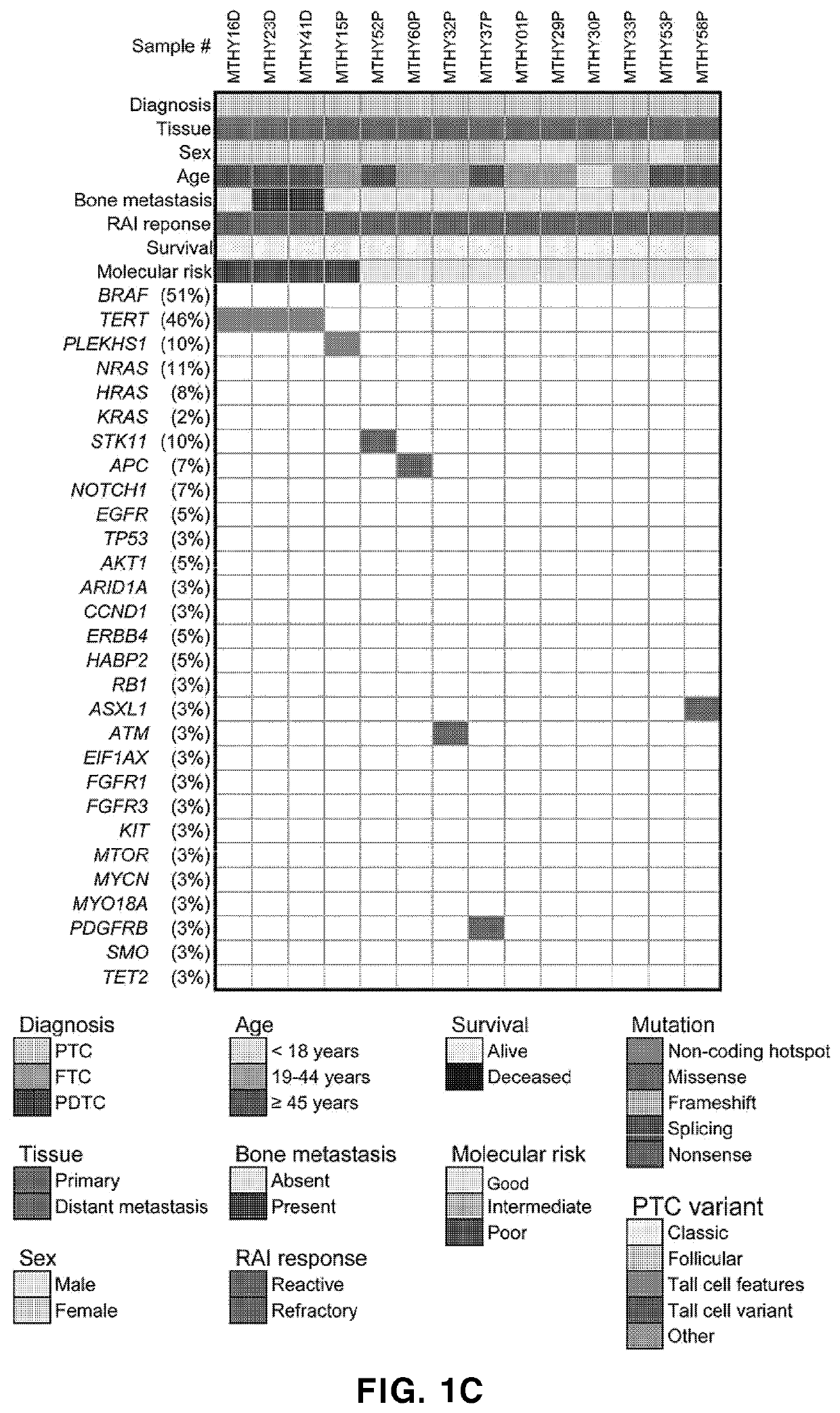Biomarker composition for diagnosing or predicting prognosis of thyroid cancer, comprising preparation capable of detecting mutation in plekhs1 gene, and use thereof
a biomarker composition and prognosis technology, applied in the direction of microbiological testing/measurement, biochemistry apparatus and processes, etc., can solve the problems of inability to determine the prognosis of individual patients, inability to accurately predict the risk of distant metastasis, and the results of genetic test results to only partially predict the clinical outcomes of patients with differentiated thyroid cancer
- Summary
- Abstract
- Description
- Claims
- Application Information
AI Technical Summary
Benefits of technology
Problems solved by technology
Method used
Image
Examples
example 1
[0110]Characteristics of Patients Studied
[0111] Patients and Tissue Samples to be Studied
[0112]61 patients with differentiated thyroid cancer treated at Seoul St. Mary's Hospital between 2006 and 2017 included 48 patients with papillary thyroid carcinomas, 9 patients with follicular thyroid carcinomas, and 4 patients with poorly differentiated thyroid carcinomas. This study was approved and conducted by the Institutional Review Board of the Catholic University of Korea, Seoul St. Mary's Hospital. All pathological slides were classified by a pathologist specializing in endocrine pathology in accordance with the latest diagnostic criteria of the World Health Organization as of 2017. Of the 61 patients with differentiated thyroid cancer included in the study, 20 had already been found to have distant metastasis at the time of diagnosis, and the remaining 41 had distant metastasis during a follow-up observation period after thyroid surgery. Distant metastasis for the 32 patients was con...
example 2
[0119]Gene Mutation Profile Analysis of Patients
[0120] DNA Isolation
[0121]Genomic DNA was extracted from a 10 μm thick formalin-fixed paraffin-embedded tissue section by utilizing the RecoverAll™ Total Nucleic Acid Isolation Kit (Life Technologies, Carlsbad, Calif., USA). After a tumor tissue compartment was set by utilizing a hematoxylin-eosin stained slide, the position of tumor tissue in an unstained tissue section was confirmed. Only the tumor tissue was accurately excised using a surgical knife while being observed under a microscope. The quantity and quality of extracted DNA was measured using an ND-1000 spectrophotometer (Thermo Fisher Scientific, Waltham, Mass.), and the concentration of DNA was measured using the Qubit 2.0 Fluorometer (Thermo Fisher Scientific) device.
[0122] Targeted Deep Sequencing
[0123]Targeted deep sequencing was performed on 61 tissues of differentiated thyroid cancer by utilizing the OncoChase cancer panel (ConnectaGen, Seoul, Korea). The OncoChase can...
example 3
[0136]Verification of Validity as Distant Metastatic Marker for Mutations
[0137]Using a digital PCR device, the present inventors intended to verify the validity of targeted deep sequencing by verifying the non-coding hotspot mutation of the PLEKHS 1 gene detected by targeted deep sequencing. The primers and probes used for the verification are shown in the following [Table 4].
TABLE 4Object to beSEQ IDTargetappliedPrimer (F, R) or probe (P) sequenceNOPLEKHS1 G590ADigital PCRF: CCAAGGCTGGGATGATCTAGAAG1PLEKHS1 G590ADigital PCRR: AGCATATCTGCAAAATTTTCCATTTCCA2PLEKHS1 G590ADigital PCRP: CTTTTTTGCAATT[G / A]AACAAT3PLEKHS1 C593TDigital PCRF: GGCTGGGATGATCTAGAAGCTTTT4PLEKHS1 C593TDigital PCRR: AAGTGCCCATAACAGAAATACAGCATA5PLEKHS1 C593TDigital PCRP: ATTGAA[C / T]AATTGCAAAATTG6TERTSanger sequencingF1: AGT GGA TTC GCG GGC ACA GA7TERTSanger sequencingRI: CAG CGC TGC CTG AAA CTC8TERTSanger sequencingF2: CAC CCG TCC TGC CCC TTC ACC TT9TERTSanger sequencingR2: GGC TTC CCA CGT GCG CAG CAG GA10TERTSanger ...
PUM
| Property | Measurement | Unit |
|---|---|---|
| thick | aaaaa | aaaaa |
| resistance | aaaaa | aaaaa |
| biomarker composition | aaaaa | aaaaa |
Abstract
Description
Claims
Application Information
 Login to View More
Login to View More - R&D
- Intellectual Property
- Life Sciences
- Materials
- Tech Scout
- Unparalleled Data Quality
- Higher Quality Content
- 60% Fewer Hallucinations
Browse by: Latest US Patents, China's latest patents, Technical Efficacy Thesaurus, Application Domain, Technology Topic, Popular Technical Reports.
© 2025 PatSnap. All rights reserved.Legal|Privacy policy|Modern Slavery Act Transparency Statement|Sitemap|About US| Contact US: help@patsnap.com



